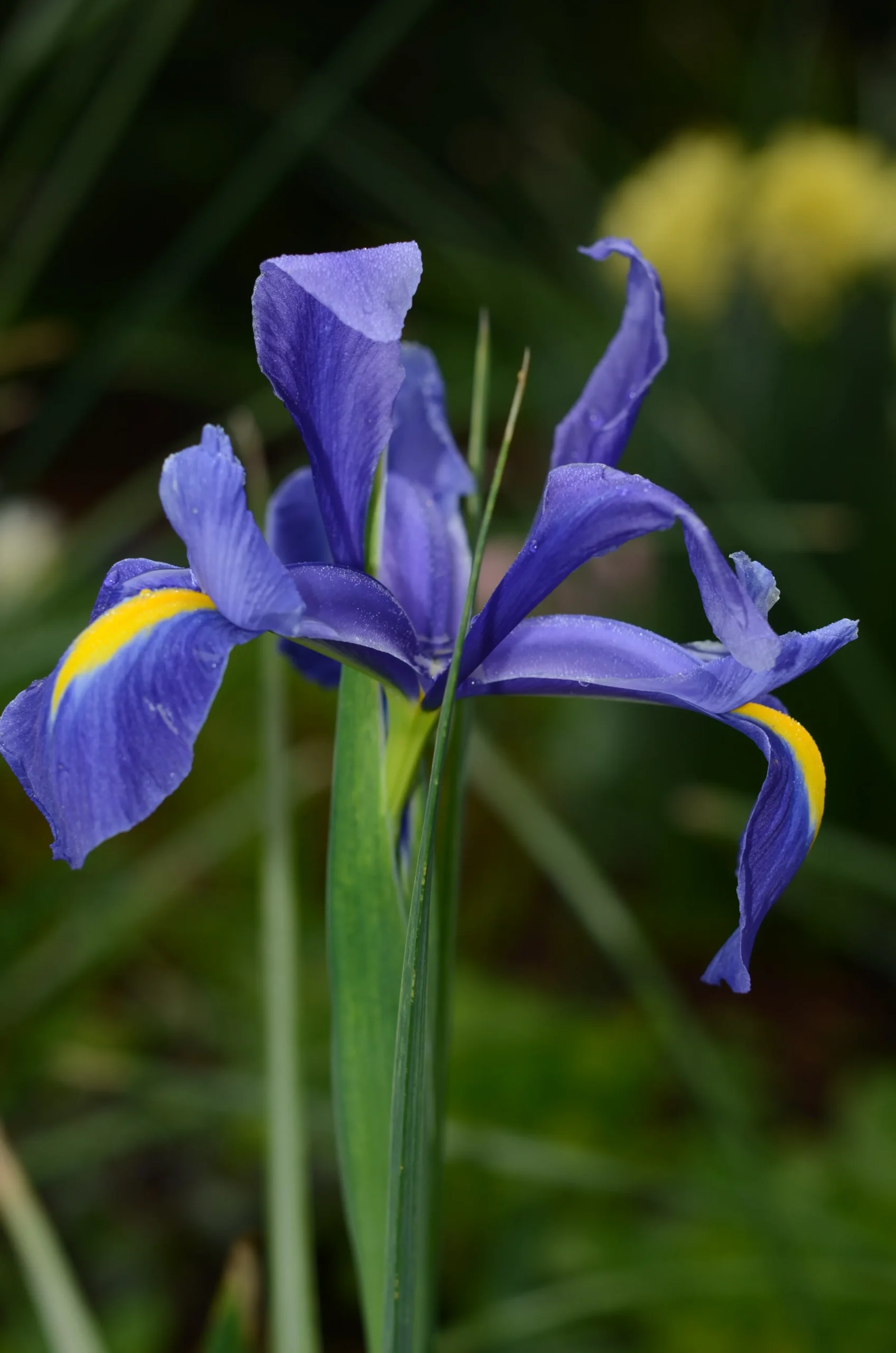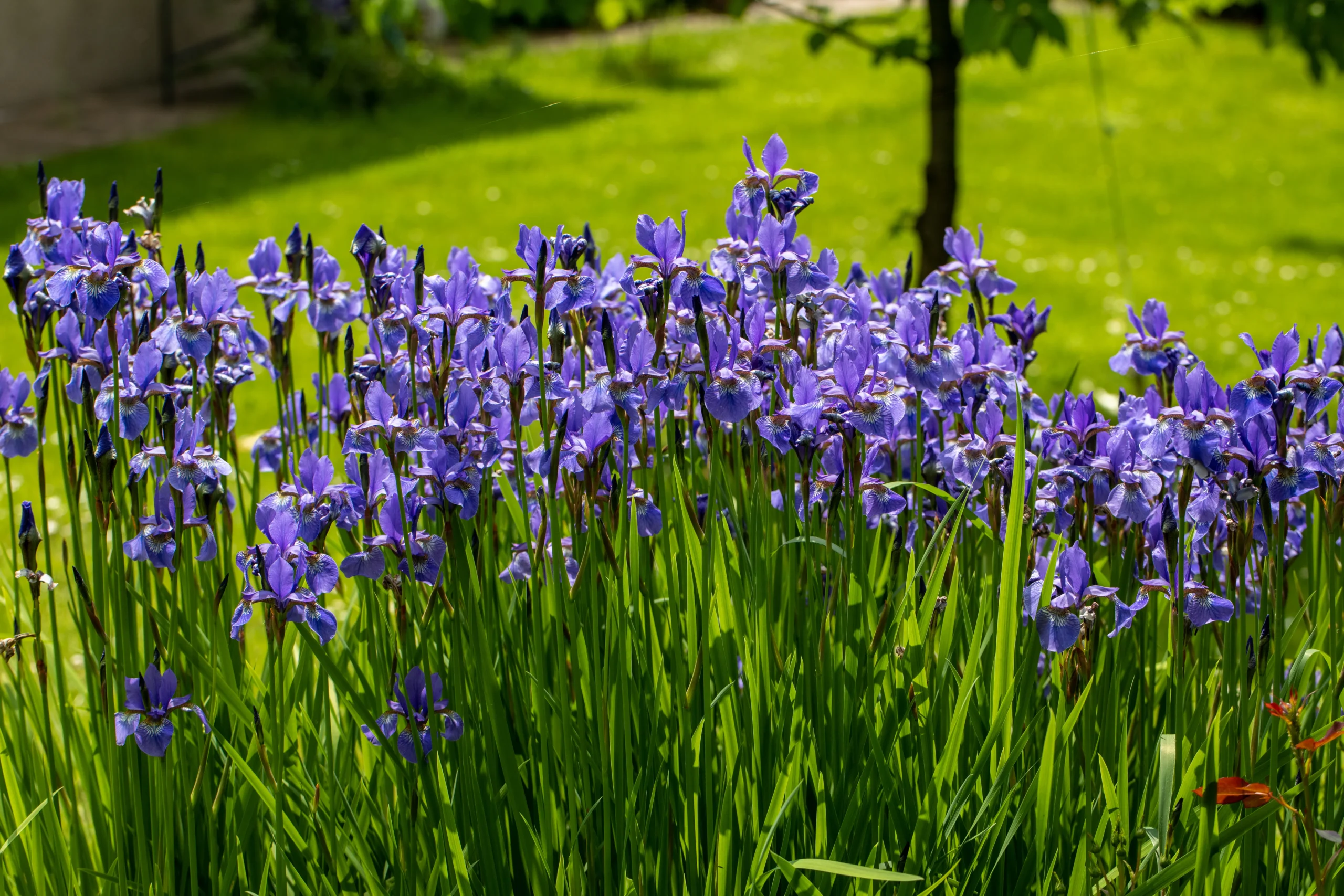Family: Iris
Type: Perennial

The Purple Flame Iris is a striking addition to any garden. Its vibrant purple blooms and lush green foliage offer a spectacular display. This plant thrives in well-drained soil and enjoys full to partial sunlight, making it versatile for various garden spots.
Landscaping with the Purple Flame Iris brings a touch of elegance and color. Its tall, slender stems and bold flowers can create stunning borders or focal points. Incorporating this iris into your yard can attract pollinators, adding life and movement to your outdoor space.
The Purple Flame Iris is relatively low maintenance, requiring minimal care once established. It’s resistant to most pests and diseases, ensuring a healthy and thriving garden presence. With its eye-catching color and graceful appearance, it’s a favorite among gardeners and landscape designers.
Hardiness Zone: 3a-8b
Deer Resistant: Yes
Pet Friendly: Yes
Moisture Preference: Average to wet
Sun Needs: Full sun to partial shade
Growth Rate: Medium
Average Height (feet): 3
Average Spread (feet): 3
Average Life Span (years): 10
Form: Over mound
Flower Color: Purple
Flower Shape: Flag
Bloom Season: In mid spring
Foliage Color: Green
Foliage Shape: Sword-Like
Integrating the Purple Flame Iris into your landscaping can transform your outdoor area. Plant them in clusters for a dramatic effect or along pathways for a welcoming walk. Their unique color and form enhance the overall aesthetic of your garden.
For a cohesive look, pair them with plants that have contrasting colors and textures. Yellow daylilies or white peonies can complement the iris’s purple hues, creating a vibrant and diverse garden palette. This approach ensures a visually appealing landscape throughout the blooming season.
Consider the Purple Flame Iris for water-wise gardening. They are drought-tolerant once established, making them ideal for xeriscaping or areas with water restrictions. Their adaptability and stunning appearance make them a smart choice for environmentally conscious gardeners.

The Purple Flame Iris fits perfectly in a cottage garden style, bringing a splash of color and a touch of whimsy. Its natural beauty enhances the informal, packed look typical of cottage gardens, blending well with a variety of perennials and annuals.
In a modern garden, the Purple Flame Iris can add an organic contrast to sleek, geometric designs. Its bold color and form stand out against minimalist landscapes, providing a focal point among more subdued plantings.
This iris thrives in the dappled shade of a woodland garden, adding brightness to the understory. Its natural resilience complements the woodland aesthetic, offering a burst of color among the greens and browns of a forested area.
Placing the Purple Flame Iris at different heights can create depth and interest in your garden. Use taller varieties in the back of borders and shorter ones in front. This layered approach maximizes the visual impact of their stunning blooms.
Incorporate the Purple Flame Iris into perennial beds for seasonal color. They bloom in late spring to early summer, filling the gap between early spring bulbs and summer perennials. Their striking color and elegant form elevate the garden’s overall look.
Use the Purple Flame Iris in container gardens. They can thrive in pots, making them versatile for patios, balconies, or small spaces. Pairing them with trailing plants in containers can create an attractive display that highlights their height and beauty.
Select our pre-made garden layouts to create a landscape that’s uniquely yours. Simple, smart, and customizable!
In spring, the Purple Flame Iris comes to life, its blooms emerging as bold, purple statements against the fresh greens of the season. This time of year, the garden begins to awaken, and the iris stands out as a herald of the warmer months to come.
During the summer, the Purple Flame Iris continues to display its vibrant flowers, though it may start to fade as the season progresses. Its foliage remains lush and green, providing a beautiful backdrop for other summer bloomers.
In fall, the foliage of the Purple Flame Iris can take on golden hues, adding to the autumnal color palette of the garden. While the blooms are gone, the plant's leaves and structure continue to contribute to the garden's overall beauty.
Winter sees the Purple Flame Iris retreat into dormancy. Its foliage may die back, but this rest period is essential for the plant to gather energy for the next blooming cycle. In areas with snow, the iris's silhouette can add interest to the winter garden.
The Purple Flame Iris thrives in locations that receive full to partial sunlight. Choose a spot in your garden that gets at least six hours of direct sunlight daily. These irises are adaptable and can be planted in borders, beds, or even containers for a versatile garden design.
Light is crucial for the health and blooming of Purple Flame Iris. They perform best in full sun but can tolerate partial shade, especially in hotter climates. In too much shade, however, they may struggle to bloom and maintain their vibrant color.
Well-drained soil is essential for Purple Flame Iris to prevent root rot. They prefer neutral to slightly acidic pH levels. Before planting, amend the soil with compost to improve its structure and fertility, ensuring a healthy start for your irises.
Space Purple Flame Iris plants about 12 to 24 inches apart. This spacing allows for adequate air circulation, reducing the risk of disease. It also gives each plant enough room to grow and spread, creating a full and vibrant display.
Plant Purple Flame Iris in late summer to early fall. This timing allows the roots to establish before winter, setting the stage for vigorous spring growth and blooming. In warmer climates, planting can be extended into the fall.
To plant Purple Flame Iris, dig a hole about twice the width of the rhizome and set it with the top exposed to the sun. Backfill with soil and water thoroughly. Planting with the rhizome partially exposed ensures the plant doesn’t get too wet and rot.
Water Purple Flame Iris deeply but infrequently to encourage deep root growth. The soil should be allowed to dry out between waterings. Overwatering can lead to root rot, so it’s essential to ensure good drainage.
Feed Purple Flame Iris in early spring with a balanced, slow-release fertilizer to support their growth and blooming. Avoid high-nitrogen fertilizers, which can promote leaf growth at the expense of flowers.
After blooming, cut back the flower stalks to the base to keep the plant tidy. Leave the foliage in place to nourish the rhizome for the next year’s growth. In late fall, remove any dead or diseased foliage to reduce the risk of pests and diseases.
In spring, remove any mulch or debris from around the irises to prevent rot. This is also a good time to apply a layer of compost and a balanced fertilizer to encourage lush growth and vibrant blooms.
During the summer, keep an eye on moisture levels, especially in hot, dry periods. Water if the soil becomes dry but be careful not to overwater. Deadhead spent flowers to maintain a neat appearance.
Prepare Purple Flame Iris for winter by trimming back foliage to about 6 inches above the ground after the first frost. Apply a light mulch layer to protect against extreme cold, but don't cover the rhizomes, which can lead to rot.
In winter, the Purple Flame Iris is dormant. No additional care is needed during this time, except in areas with harsh winters, where a light mulch can help protect the plants. Remove the mulch in early spring to allow new growth.
Purple Flame Irises typically bloom for a 3 to 4-week period in late spring to early summer. Deadheading spent flowers can sometimes encourage a second, though less vigorous, bloom period.
Yes, Purple Flame Iris can be successfully grown in pots. Ensure the container has adequate drainage holes, use well-draining soil, and follow general care tips. Containers offer the flexibility to move the irises to optimal locations for sunlight and protection.
Divide Purple Flame Iris in late summer, every 3 to 5 years, to prevent overcrowding and maintain vigor. Gently lift the clumps, separate the rhizomes, and replant them immediately. This rejuvenates the plant and encourages more blooms.
Sign up below to get exclusive deals, discounts, and new plant collections—delivered straight to your inbox! Plus, stay inspired with the latest gardening tips, landscaping trends, and DIY garden ideas. Start growing with us today!
A big thank you for subscribing to the PBN Design newsletter.
We're thrilled to have you join our community. Get ready for exciting updates, insightful content, and more delivered straight to your inbox.
Stay tuned!
Go backA big thank you for subscribing to the PBN Design newsletter.
We're thrilled to have you join our community. Get ready for exciting updates, insightful content, and more delivered straight to your inbox.
Stay tuned!
Go back